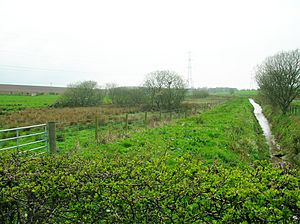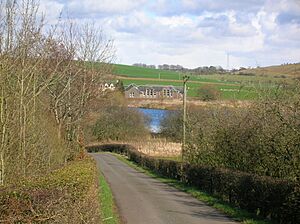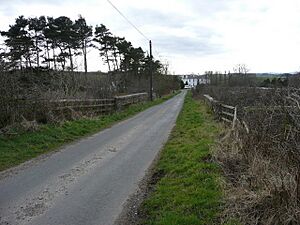Trabboch facts for kids
Trabboch is a small village, also called a hamlet, in East Ayrshire, Scotland. It was built in the 1880s for miners and their families. A company called Wm. Baird & Co., Ltd. owned and rented out the houses. At one time, there were 94 homes here. These miners' houses stood on the road between Stair and Littlemill until they were taken down in 1969. Trabboch is about two miles south of Stair. People in the area say the name like 'Traaboch'.
Contents
History of Trabboch
What's in a Name?
The name Trabboch was first written down in 1303 as Trebathe. It comes from an old language called Brittonic. The first part, treβ-, means a place where people live and the land around it. This is like the Welsh word tref, which means "a town" or "a farm".
The second part of the name might mean "birch trees" (like the Welsh word bedw). Or it could mean "a grave" (like the Welsh word bedd). The way we say Trabboch today has been influenced by a Scottish Gaelic word, beitheach, which also means "of birches".
Life in the Mining Village
The mining village of Trabboch had four rows of houses. One row had 40 houses, and three others had 18 houses each. About 430 people lived there.
The Trabboch coal pit closed in 1908. The Drumdow pit, another coal mine nearby, closed a few years later. Trabboch House, a large home nearby, belonged to the person who owned the coal pits. After the mines closed, the old workings filled with water, creating a new 'loch' or lake. The piles of waste material from the mines, called bings, can still be seen today.
When the miners' houses were taken down, many families moved to Drongan. Some miners who stayed in the area traveled by train to work at Whitehill Colliery in Skares. Others found jobs at Burnockhill Colliery, which was closer.
Stair School in Trabboch
Stair school opened in 1863 and was located right in Trabboch. It was always used as the Village Hall and later became the Stair Community Centre. The school grew and became a Junior Secondary school, teaching as many as 150 to 200 students. It closed its doors in 1969. Miss Brown was the last headteacher.
Trabboch Castle and Its History
Trabboch is also known for its old castle, Trabboch Castle. The land around Trabboch was first mentioned in records from 1303–4. King Robert the Bruce gave the castle to the Boyd family of Kilmarnock. This was a reward for their help at the famous Battle of Bannockburn.
By 1451, the land belonged to William, Earl of Douglas. Later, it passed to the Boswell family of Auchinleck. In the 1600s, parts of the Trabboch area were owned by the Chalmers of Gadgirth and the Reid of Barskimming families. The Mill of Trabboch, a watermill, was on the Water of Coyle river. It did not use water from the loch. Trabboch Mains is a farm that was built mostly with stones taken from the old Trabboch Castle nearby.
Trabboch Railway Station
Trabboch railway station was part of the Glasgow and South Western Railway line. This line connected Ayr and Cumnock. The station opened in 1872 and closed on September 10, 1951.
The Trabboch Lochs
There are two important lochs (lakes) near Trabboch. Trabboch Loch was formed when the old Drumdow Colliery mine workings flooded in the late 1800s. The Loch of Trabboch was a very old loch, created by glaciers long ago. Later, it was used for curling, a sport played on ice. Today, what's left of it is a wetland, which is a very important home for many different birds.
The Shaw Kirk or Stair Free Church
The Schaw or Shaw Kirk (church) is now a ruin, meaning it's falling apart (as of 2011). It was built in 1843-4 near the Shaw Burn, which is on the edge of the parish. The church was left empty in 1956. This happened because a new church was built in Drongan. Many people from Trabboch had moved to Drongan after their miners' houses were taken down.
In the 1890s, the church was made bigger. It got a nice wooden porch and a new wing on the east side, making it cross-shaped. Two other buildings stood north of the church. Its last use was as a storage place for a local farm. The manse, which was the minister's house, is still a private home on the road leading to Trabboch Burn.
Quick Facts
An SS Trabboch was a ship that was sunk in 1914. It was sunk by a German ship called the Emden in the Indian Ocean.





